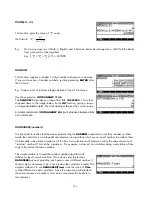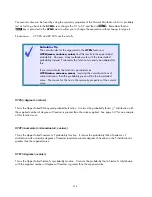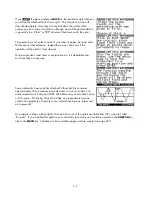
Solving a system of equations
Another method is to store the result into a third matrix and then to view it through the Edit screen of the
MATRIX Catalog
. This is shown below.
Matrix
M3
is
created left and
edited right.
Probably the most common functions that you will use are
INVERSE, DET
and
TRN
(transpose), so some
worked examples are included which use them. There are also a number of further worked examples
involving matrices in the section at the back of the book.
x
y
z
+
⎧
2
3
− = −
6
⎪
⎨
x
y
z
Eg. 1
Solve the system of equations:
−
3
+
=
12
⎪
3
− +
4
13
x
y
z
=
⎩
2
3
1
−
−
6
⎤ ⎡ ⎤
⎡
⎤
⎡
x
y
⎥ ⎢ ⎥
⎢
⎥
=
12
⎥ ⎢ ⎥
⎢
⎥
⎢
⎢
Solution:
The system of equations can be
1
3
1
−
represented as the system of
⎢⎣
z
⎥ ⎢ ⎥
⎢
⎥
13
⎦ ⎣ ⎦
⎣
⎦
3
1
4
−
matrices:
⎡ ⎤ ⎡
−
1
2
3
1
−
−
6
⎤
⎡
⎤
x
y
z
⎢ ⎥ ⎢
−
⎥
⎢
⎥
=
12
⎢ ⎥ ⎢
1
3
1
⎥
⎢
⎥
⎢ ⎥ ⎢
⎣ ⎦ ⎣
and this system can then be algebraically
rearranged to:
3
1
4
⎥
⎢
⎥
13
−
⎦
⎣
⎦
−
⎡
2
3
1
⎤
−
1
where the inverse matrix is…
⎢
−
⎢
1
3
1
⎥
⎥
⎢
3
1
4
⎥⎦
⎣
−
2
⎡ ⎤
⎡
⎤
x
y
⎢ ⎥
⎢
⎥
= −
3
⎢ ⎥
⎢
⎥
which gives a final answer of
z
⎢ ⎥
⎢
⎥
1
⎣ ⎦
⎣
⎦
The method for doing this on the calculator is as follows…
Step 1. Enter the
MATRIX Catalogue
. Use
SHIFT CLEAR
to erase all
matrices if desirable.
211






























